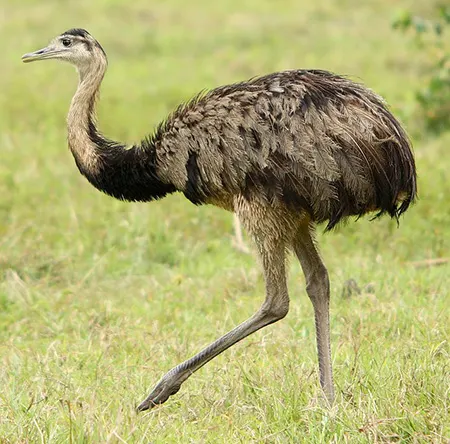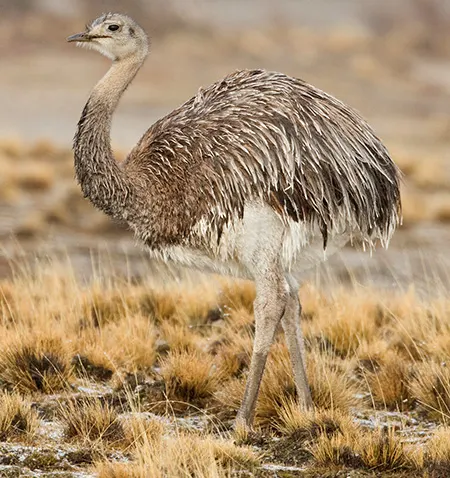
(Rheiformes)
Rheas
Нандуподібні
The rhea, also known as the ñandu or South American ostrich, is a South American ratite (flightless bird without a keel on the sternum bone) of the order Rheiformes. They are distantly related to the two African ostriches and Australia’s emu (the largest, second-largest and third-largest living ratites, respectively), with rheas placing just behind the emu in height and overall size.
Rheas are from South America only and are limited within the continent to Argentina, Bolivia, Brazil, Chile, Paraguay, Peru and Uruguay. They are grassland birds, and prefer open land. The greater rheas live in open grasslands, pampas and chaco woodlands. They prefer to breed near water and prefer lowlands, seldom going above 1,500 m. On the other hand, the lesser rhea will inhabit most shrubland, grassland, even desert salt puna up to 4,500 m.
Individual and flock behavior
Rheas tend to be silent birds, except when they are chicks or the male seeks a mate. During the breeding season, the male will attempt to attract females by calling. This call is a loud booming noise. While calling like this, they will lift the front of their body and ruffle their plumage, all while keeping their neck stiff. They will then extend and raise their wings and run short distances, alternating with their wings. He may then single out a female and walk alongside or in front of her with a lowered head and spread wings. If the female notices him, he will wave his neck back and forth in a figure eight. Finally, a female may offer herself, and copulation will commence.
During the non-breeding season they may form flocks of between 20 and 25 birds, although the lesser rhea forms smaller flocks than this. When in danger, they flee in a zigzag course, using one wing and the other, similar to a rudder. During the breeding season, the flocks break up.
Feeding and diet
Mostly, rheas are herbivorous and prefer broad-leafed plants, but they also eat fruits, seeds, roots, and insects such as grasshoppers, small reptiles, and rodents. Young rheas eat only insects for the first few days. Outside the breeding season, they gather in flocks and feed with deer and cattle.
Reproduction
Rheas are polygynandrous, with males courting between two and twelve females and females commonly mating with multiple dominant males during the breeding season. After mating, the male builds a nest where each female lays eggs. The nest is a simple scrape in the ground, lined with grass and leaves. The male incubates from ten to sixty eggs. The male will use a decoy system and place some eggs outside the nest, then sacrifice these to predators so they do not attempt to get inside the nest. The male may use another subordinate male to incubate his eggs while he finds another group of females to start a second nest with. The chicks hatch within 36 hours of each other. Right before hatching, the chicks begin to whistle. The group of females, meanwhile, may move on and mate with other males. While caring for the young, the males will charge at any perceived threat approaching the chicks, including female rheas and humans. The young reach full adult size in about six months but do not breed until they reach two years of age.
Predators
The natural predators of adult greater rheas are limited to the cougar (Puma concolor), which are found in most areas inhabited by greater rheas and are certain to be their leading predator, and the jaguar (Panthera onca), which are found with greater rheas and opportunistically hunt them in the Paraguayan chaco, central Bolivia and the Brazilian cerrado. Feral dogs are known to kill younger birds, and the crested caracara (Caracara plancus) is suspected to prey on hatchlings. Armadillos sometimes feed on greater rhea eggs; nests have been found which had been undermined by a six-banded armadillo (Euphractus sexcinctus) or a big hairy armadillo (Chaetophractus villosus) and the rhea eggs were broken apart. Predation on young rheas has also been reportedly committed by greater grisons (Galictis vittata).

(Rhea americana)
Greater Rhea
Нанду великий
It is native to Argentina, Bolivia, Brazil, Paraguay, and Uruguay. It inhabits grasslands, as well as savannas, scrub forests, chaparral, and even desert and palustrine habitats, at elevations up to 1,200 m.

(Rhea pennata)
Lesser Rhea
Нанду малий
It lives in areas of open scrub in the grasslands of Patagonia and on the Andean plateau (the Altiplano), through the countries of Argentina, Bolivia, Chile, and Peru. It occurs at elevations of 0–2,000 m.

